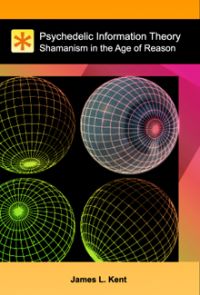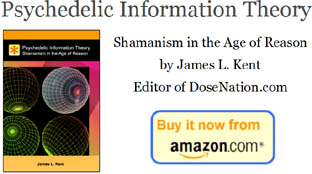An Interview with James Kent about 'Psychedelic Information Theory'
 |
With R.U. Sirius, from H+ Magazine. The Spontaneous Creation of New Information.
H+: What recent developments in neurological research have influenced your theory, and why?
JK: The research informing my theory has come from a variety of directions. I would say the first sense I had that I was onto a good working model started after reading Joseph Ledoux's Synaptic Self and Emotional Brain. I spent some time studying Ledoux and connective neuroanatomy, so I had a fairly strong idea of how sensation propagates through the brain to inform perception. That gave me a physical system to work with. Then I read J. Allan Hobson's work on acetylcholine, psychosis, and dreaming in The Dream Drugstore, and that gave me a pretty good understanding of memory and visual memory gating between the hippocampus and the frontal cortex. After that I went through Paul Bressloff and Jack Cowan's work on spatial visual networks, which demonstrates how destabilization in neural oscillations between the retina and visual cortex leads to various types of overlaid geometric hallucinations. There were plenty of others, but these three areas of research helped me solidify my working theory that all psychedelic phenomena are related to loss of feedback control in recurrent perceptual systems.
The theory I was formulating suggested that psychedelics promote feedback excitation in perceptual circuits to create sustained over-saturated states of sensual intensity. I did not know that Franz Vollenweider had already published a similar theory, but his model of under-constrained perception in sensory feedback loops is very similar to the model I had already settled on. This continuous feedback model was then refined into the Frame Stacking model on the suggestion of an anonymous Canadian researcher who had read my work. The Frame Stacking model helped describe the potential depth of nonlinear feedback hallucination in a very formal way: it was my first move towards a more quantum description of expanded states of consciousness. The Control Interrupt model of psychedelic action was the second piece of the quantum description, defining hallucinogenic action in terms of wave packets interrupting multisensory perception. This was my own conception based primarily on first-hand research, but was also informed by research coming out of Dave Nichols' lab, the survey of psychedelic receptor targets by Thomas Ray, an article on psychosis and Bayesian information processing in the brain by Phil Corlett, and other underground research. Most of the work I cite was published within the last three to five years, and most of it focuses only on one piece of the overall puzzle. With PIT I've tried to take all this current research and tie it together in a formal meta-analysis that makes some sense. The Control Interrupt and Frame Stacking models are what came out of this process.
|

Recently @ DoseNation
|
|






















[link]
The comments posted here do not reflect the views of the owners of this site.